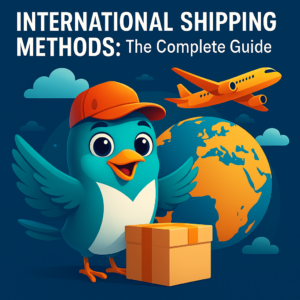There are several international shipping methods to choose from and each has its benefits. Here is an in-depth look at the different shipping methods, what they involve, and how they work. Find out which way is best for you!
International shipping can be a hassle, but it doesn’t have to be! With access to various service methods, you can find the best one for your needs. Here is an in-depth look at the different shipping methods, what they entail, and how they work. Find out which one will work best for you!

International Shipping
If you need to transport a package overseas, you have a few alternatives. Boats, planes, trains, cars, and trucks are all utilized to transport products between states. Nonetheless, different delivery techniques are better suited to different scenarios. When people talk about international shipping, they usually refer to transporting by air with an airplane or by sea with a ship. Each option has its strengths and weaknesses. So it would be best if you determined what exactly you want from your international shipping service before you can decide which choice is right for you.
Sea transport: sea transport usually takes longer. Also, if your current or future home is far from a major seaport, you will need to allow even extra time. Travel by sea is always slow, but these cargo ships tend to make many stops at different ports, and your dock may not be the first on the list. Sea shipments can take anywhere from a few weeks to a few months to arrive at their destination.
Air Freight: Air transport is much faster than sea transport; sometimes 30 times more rapid. You can have an international air freight shipment in as little as a day or two.
If you are shipping a small package, you will probably use a courier service.
Which shipping method should you use?
There are a few things you should consider when choosing the best method to ship your goods. We would say that these are mainly:
Size of the products: The size of the items heavily influences the price of all forms of international shipment. Courier services and air freight become substantially more expensive for loads larger than a specific size. On the other hand, it is not worthwhile to pay for sea freight for packages that fall below a particular size (about 100 kg and 0.5 cubic meters).
Price Many customers just want to find the cheapest way to transport products internationally. Being flexible with delivery schedules might save you a significant amount of money. For a moderately large consignment, airfreight/courier can cost four times as much as ocean freight.
How fast you need your goods: The shipment times are a significant variation between various international shipping providers. Sea freight from China might take 6-7 weeks, but courier services can be as quick as three days.

How Parcel Deliveries Work
The Process:
When it comes to the customer, then parcel deliveries are supposed to be efficient. You enter your delivery details, compare the quotes, and pick the right option for you. However, when you look behind the scenes, you will know that there is more to it than that. There are many steps needed to ensure that your parcel will be collected and then delivered to the selected destination quickly and safely.
- 1. Your courier will collect the parcel from a drop-off location or a particular address
- 2. The parcel, along with hundreds of others, will be taken to the nearest depot
- 3. Your parcel will then be sorted with other parcels to go to similar areas, and they will be sent to another depot that is closer to the delivery location
- 4. The parcel will get assigned to a specific driver based on the coverage area
- 5. The driver will then take your parcel and deliver it to your recipient on their delivery route.
Tracking Your Parcel Deliveries
Tracking ShippingToGo delivery is very easy. Just enter the tracking reference number into our postal tracking tool in your confirmation email, and then click “Track this package.” You can track the package at various points during the entire travel process of the package to know the location of the package at any time so that you and the recipient can be at ease.
After the package is collected, once the package is scanned, package tracking will start, and the driver with a handheld terminal will scan the package immediately. Other packages can only be displayed as collected after being scanned in the express warehouse.
Is It Possible to Track Standard Parcel Deliveries?
Yes, all our standard deliveries can be tracked for free. This can be done by the way you use ShippingToGo to track any other delivery service. Enter your tracking reference number in our postal tracking tool and click “Track this package.” Your package can be tracked immediately after being collected and scanned by one of the drivers, or it can be tracked immediately after being scanned at the courier station. The package can be tracked at various points in its journey until it reaches its final destination.
Picking The Right Parcel Delivery Service
Knowing which package delivery service to use is not always easy because there is no direct answer. The service you choose will be the one that best suits your needs. There are several things you should consider when choosing the right service for you. The first is whether you need to pick up or drop off
If you spend most of the day in one place; maybe you work from home or collect items from the office, then the collection service will become simple and convenient.
However, if your schedule is hectic and you cannot allocate a whole day or even a few hours to wait at home, then the pick-up service will be the ideal choice. There are thousands of drop-off locations across the country so that you can find one nearby
The next thing to check is the speed of the package delivery. If it is urgent, you may want to make a reservation on the same day or the next day. If there is no urgent matter and you want a more affordable option, please consider delivery in two or three days.

The Best Parcel Delivery Company
Just like choosing the exemplary service for you, choosing the right package delivery company may also have some question marks.
The courier you choose to book will depend on your needs, and you will need to consider the time frame, budget, whether you need a collection or delivery service,
and the location of the package. To make things easier, we provide a courier comparison service that allows you to visit the most comprehensive range of courier companies in the UK.
We only work with the best courier companies, so you can rest assured that you will get the best service no matter which carrier you choose. Below we have listed some of the most popular services.
Conclusion
Small goods that need to get to their destination quickly can be sent through air freight.
Sea shipping is the way to go if you are worried about the environment and cost and need to transport more oversized items. The most major distinction between air and sea shipping is one of time.
Typically, such speed comes at a higher cost. It is determined by your specific requirements as well as the size of your cargo.